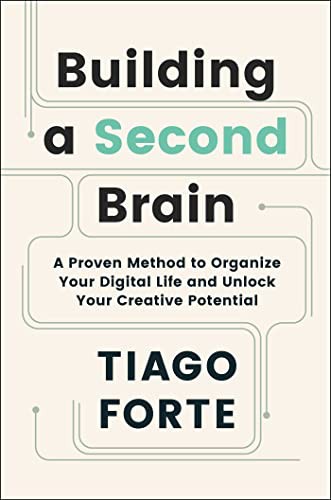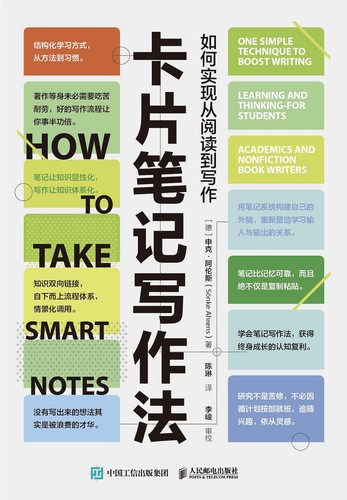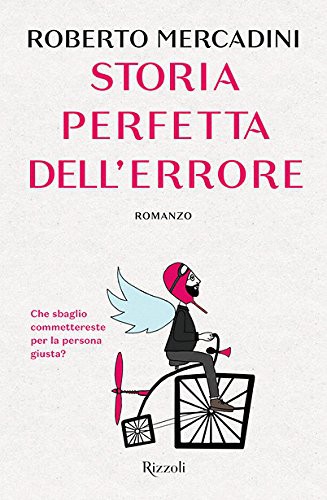folini rated Building a Second Brain: 4 stars

Building a Second Brain by Tiago Forte
For the first time in history, we have instantaneous access to the world’s knowledge. There has never been a better …
EN: Marketer & marketing instructor with IT background. I love to read, learn, and discover new tools & technologies. After many years in Silicon Valley, I now live in the Italian Alps, my ideal MTB and trail-running place!
IT: Mi occupo di Digital Marketing come consulente e ho un background e una laurea da informatica. Mi piace leggere, scoprire e provare nuove tecnologie, e strumenti. Dopo anni passati in Silicon Valley, vivo in Valtellina, il luogo ideale per MTB e trail running.
This link opens in a pop-up window

For the first time in history, we have instantaneous access to the world’s knowledge. There has never been a better …
Se vi piace lo stile di Andrea Vitali questo libro è perfetto. Grande potere evocativo di nomi, soprannomi, e vicende scelta con grande maestria. Non so se lo definirei un'opera artistica, ma certamente è un modo molto piacevole di trascorrere alcune ore voltando pagine e perdendosi in un mondo che non esiste più.
Se vi piace lo stile di Andrea Vitali questo libro è perfetto. Grande potere evocativo di nomi, soprannomi, e vicende scelta con grande maestria. Non so se lo definirei un'opera artistica, ma certamente è un modo molto piacevole di trascorrere alcune ore voltando pagine e perdendosi in un mondo che non esiste più.

轻松写就58本书和上百篇论文的卡片盒笔记写作法!
德国著名学者卢曼基于学习心理学的洞察,借鉴久经考验的笔记技术,使用卡片盒笔记写作法,积累了 9万张知识卡片,一生中写了 58本书和上百篇论文。
本书是该系统的第一本中文综合指南和说明,本书分为三个部分,第一个部分从写作知识、写作准备、写作能力和注意事项四个角度概述写作的基本问题;第二部分总结了有效写作的四个原则;第三部分是成功写作的六个步骤。详细解释了卡片盒笔记写作法的工作原理和具体写作方法,这一方法可以帮助我们将精力集中在真正重要的事情上——思考、理解和提出新的写作思路,而不用将时间浪费在寻找笔记、资料或参考文献上。
无论你喜欢用笔和纸,还是喜欢在Windows、Mac或Linux上做笔记都没关系,这个方法都能够轻松应用。
德国的卢曼被称为“当代黑格尔”,是马克思和韦伯之后,百年一遇的具备天才卓识的大师。作为20世纪社会理论界的一颗明星,卢曼以其辉煌作品的灿烂光芒,照耀着整个20世纪下半叶西方当代社会理论的发展进程。他的写作方式别具一格,37岁才投身学术界,并只用了一年时间就获得了在德国很难获得的博士学位。他生前发表了58本书,及数百篇文章,不仅高产,而且《社会的社会》、《社会的艺术》等都成为影响深远的新经典。在本书中详细公开他成就背后的秘密——卡片笔记写作法,即使普通人不一定能够著作等身,但一定不再为写作发愁。
从根本上改变写作难,学会卢曼的卡片笔记写作法,将会发现无论是写论文、还是写书都不再是不可能实现的任务。传统先定写作目标和计划,自上而下地写,所以会感觉被逼无奈、事倍功半,而卡片笔记法是从平日就已经在构建自己的知识库,等有灵感的时候,才提取储备的知识,所以写起来兴致盎然。
本书的作者借鉴了卢曼的卡片笔记写作法,所以这本书也算是一个学习成果,每个见解都综合了许多商业、心理学的相关研究,不仅提高了写作技能,也全面提升学习技能。英文版豆瓣评分8.8,想读近3000人,受欢迎程度可见一斑。
2020年,有两件事情深刻影响了我。阅读本书的英文版,便是其中的一件。多少年记笔记过程中的痛点,都被这本书娓娓道来,并且采用了令人信服、可执行的方法来破解。笔记不再是那“被忘却的纪念”,而是构成了一张硕大的思维之网,可以找到,可以积累,可以偶遇。这种方法升级的快感,我已经多年没有体会到了。感谢译者陈琳将本书原汁原味地翻译成了中文。让更多读者有机会重新找回记笔记的激情与乐趣。
…To get an excellent non-fiction book, you need a great topic and a skilled writer. The "quest to revive the woolly mammoth" is a great topic (that's the reason I purchased the book). The author must have a reasonable ability to write the story compellingly.
This book didn't make it to the "excellence" level. I'm not sure if it even reached the "decent" level. What is missing is sincere passion, creativity. The book is a collection of stereotypes about scientists and about the craziness of genius people. With Ben Mezrich, the author, everything becomes a forced adventure, even when it's not. On a scale of one to ten, everything in the book is at level 10 of excitement. Ben is not interested in building a connection between the reader and the characters of the story. He believes that creativity means telling everything as super exciting, super exceptional. He is wrong. …
To get an excellent non-fiction book, you need a great topic and a skilled writer. The "quest to revive the woolly mammoth" is a great topic (that's the reason I purchased the book). The author must have a reasonable ability to write the story compellingly.
This book didn't make it to the "excellence" level. I'm not sure if it even reached the "decent" level. What is missing is sincere passion, creativity. The book is a collection of stereotypes about scientists and about the craziness of genius people. With Ben Mezrich, the author, everything becomes a forced adventure, even when it's not. On a scale of one to ten, everything in the book is at level 10 of excitement. Ben is not interested in building a connection between the reader and the characters of the story. He believes that creativity means telling everything as super exciting, super exceptional. He is wrong. The result is a boring book that slowly and tiredly flows from one page to the next, generating in the reader more frustration than curiosity.
Pare impossibile che le scuole raramente menzionino questo importantissimo evento della storia locale valtellinese. Un evento che non solo dovrebbe insegnare a tutti noi a diffidare delle categorie "buoni" e "cattivi", ma che aiuterebbe anche a capire le ragioni della decadenza economica della Valtellina, decadenza che il Sacro Macello ha causato innescando una serie lunghissima di guerre, dominazioni e devastazioni. Da terra ricca, culturalmente e religiosamente libera, la valle si trasformò nel giro di pochi anni in un territorio abitato solo da nobili decaduti e contadini impoveriti. La popolazione si ridusse da oltre 150 mila abitanti all'inizio del 1600 a soli soli 40 mila dopo il passaggio dei Lanzichenecchi. Leggendo questo libro riscopriamo una terra che sotto la dominazione elvetica ospitava un vivace dibattito culturale e religioso, pubblicava trattati filosofici e religiosi, intratteneva commerci con l'Europa e il resto dell'italia. Di tutto questo, nel volgere di pochi anni rimase ben …
Pare impossibile che le scuole raramente menzionino questo importantissimo evento della storia locale valtellinese. Un evento che non solo dovrebbe insegnare a tutti noi a diffidare delle categorie "buoni" e "cattivi", ma che aiuterebbe anche a capire le ragioni della decadenza economica della Valtellina, decadenza che il Sacro Macello ha causato innescando una serie lunghissima di guerre, dominazioni e devastazioni. Da terra ricca, culturalmente e religiosamente libera, la valle si trasformò nel giro di pochi anni in un territorio abitato solo da nobili decaduti e contadini impoveriti. La popolazione si ridusse da oltre 150 mila abitanti all'inizio del 1600 a soli soli 40 mila dopo il passaggio dei Lanzichenecchi. Leggendo questo libro riscopriamo una terra che sotto la dominazione elvetica ospitava un vivace dibattito culturale e religioso, pubblicava trattati filosofici e religiosi, intratteneva commerci con l'Europa e il resto dell'italia. Di tutto questo, nel volgere di pochi anni rimase ben poco. La causa primaria è chiaramente identificata da Cesare Cantù nel Sacro Macello di Valtellina e negli eventi che a cascata ne seguirono, indotti certamente da quella ignobile e feroce strage.
Una lettura revisionista e giustificazionista dei fatti, promossa principalmente da bigotti cattolici, sta provando e riscrivere questo triste momento di storia come una rivolta dei valtellinesi verso gli oppressori elvetici, dimenticandosi che le vittime del macello furono quasi esclusivamente valtellinesi. I carnefici non si limitarono ai protestanti, ma infierirono anche su quei pochi cattolici che tentavano di proteggere i riformati.
Il libro di Cesare Cantù, anche se chiaramente scritto da un cattolico, è ricco di fatti oggettivi e offre al lettore l'opportunità di farsi un'opinione interpretando i fatti e collegandoli a formare un quadro ragionevolmente completo di quel periodo storico. La lettura è inizialmente difficile a causa di un italiano arcaico e accademico (dell'ottocento) ma presto ci si abitua e le pagine scorrono veloci arricchendo il lettori con nuovi fatti, dettagli e dati importanti.

Jeffrey G. Madrick: Seven bad ideas (2014)
"The author of the widely praised Age of Greed now gives us a bold indictment of some of our most …
After a few years sitting on my shelves, in the last couple of weeks, I started and finished the book Bury My Heart at Wounded Knee by Dee Brown. It’s an iconic and popular book, with thousands and thousands of online reviews, so it’s tough for me to add anything new to the conversation.
In this book review, I would state my impressions and thoughts without going over the content of the book.
First of all, let me say that this is a critical book. It tells a piece of American history that has mostly been hidden to the average American. We all know that history is usually told and shaped by the winners. Thanks to this book, we have access to a different version of history. This version is coming from the native Americans’ perspective, from the people who lost the war, although the author is not a Native …
After a few years sitting on my shelves, in the last couple of weeks, I started and finished the book Bury My Heart at Wounded Knee by Dee Brown. It’s an iconic and popular book, with thousands and thousands of online reviews, so it’s tough for me to add anything new to the conversation.
In this book review, I would state my impressions and thoughts without going over the content of the book.
First of all, let me say that this is a critical book. It tells a piece of American history that has mostly been hidden to the average American. We all know that history is usually told and shaped by the winners. Thanks to this book, we have access to a different version of history. This version is coming from the native Americans’ perspective, from the people who lost the war, although the author is not a Native American. It’s the story of a war Indians didn’t initiate, they didn’t want, and that took the lives of the majority of them.
Ths book goes through a long list of conflicts between mostly peaceful Indian tribes and the expanding American population. Sometimes the pressure comes from miners, other times from farmers, or the builders of the railway. Every single time, the political establishment and the military support the aggressions of the Indians and their killing or imprisonment. As we all know, the government of the United States forced the few surviving Native Americans into small reservations. Indian Reservations were established in areas so inhospitable and hard to cultivate that did not attract any interest from the colons or the gold miners. The list of Indian-American conflicts is also a list of treaties that Americans always violated to take advantage of the native people.
The greed for land, natural resources, and easy money was the main drive pushing colons and miners to the west. The immense and unprecedented land grab didn’t stop until the last piece of valuable land was under the control of the whites.
If there is a lesson we can learn from those tragic historical events and the genocide of the Native Americans is that the greed, the real engine of the capitalistic system, only stops when it runs out of resources to grab or steal and to convert into money.
I see this book and the tragic story of the Native Americans as a metaphor for the current struggle of those trying to save our planet form the exploitation by the capitalistic system. In the 1800 century, Americans colons and business people didn’t stop until they had full control of the natural resources and territories of Native Americans. Similarly, today’s capitalistic system will not stop until our planet resources are exhausted, even if this means to push global warming to a level that puts us, humans, in danger of extinction.

È dal caos e dall'imperfezione che nascono le cose più belle.
«Una storia d'amore avvincente» – Guido Catalano
…